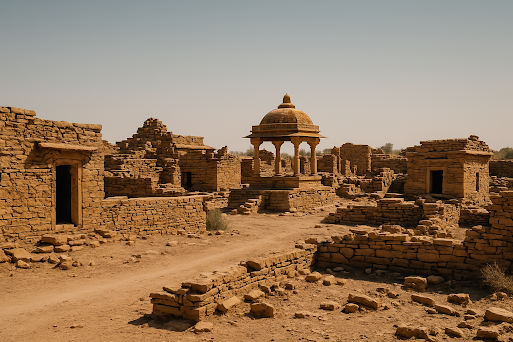🌞 Konark Sun Temple: The Celestial Chariot of Stone
Where Ancient Engineering Meets Divine Splendor
🌅 Standing majestically on Odisha’s eastern coastline, the Konark Sun Temple isn’t just a temple—it’s a cosmic time machine sculpted from stone. A 13th-century masterpiece, it honors Surya, the Hindu Sun God, through its breathtaking architecture and symbolism.
📍 Location: Konark, Odisha (35 km from Puri)
🕰️ Built: 1250 CE by King Narasimhadeva I of the Eastern Ganga Dynasty
🏛️ UNESCO World Heritage Site: Inscribed in 1984
🏗️ Architectural Style: Kalinga architecture
🚂 The Architecture: A Chariot to the Heavens
🛞 Symbolism in Stone:
The temple is envisioned as Surya’s divine chariot, racing across the sky:
-
12 pairs of intricately carved wheels represent the 12 months of the year
-
7 galloping horses symbolize the 7 days of the week
-
The temple faces east, aligning with the sunrise—a tribute to its deity
⚙️ Engineering Genius:
✔️ Shadow Sundials: The massive 3-meter wheels function as accurate sundials—you can tell time by the shadows cast on them!
✔️ Precision Carvings: Over 2,000 stone sculptures depict celestial beings, musicians, dancers, flora, fauna, and erotic Kama-Mithuna art
✔️ Magnetic Core (Legend): Local lore suggests a powerful magnet once held the temple's top together and disrupted nearby ship compasses—although this remains unproven
🧱 Original height of the main tower (Shikhara): ~70 meters (225 ft)—taller than the Colosseum in Rome!
⚡ The Rise, Glory & Fall:
🛕 Golden Age of Konark:
-
Built over 12 years by 1,200+ artisans and engineers
-
Flourished as a major pilgrimage and cultural hub until the 16th century
💔 The Mysterious Collapse:
-
Main sanctum (Vimana) collapsed between 1550–1600 CE
-
Possible reasons:
-
Structural instability
-
Coastal erosion & cyclones
-
Invasion by Kalapahad, a general of the Bengal Sultanate
-
🏖️ Buried & Rediscovered:
-
Temple buried under sand over centuries
-
Rediscovered and partially excavated by British archaeologists in 1837
🔍 Top Attractions You Can’t Miss:
🏛️ 1. Jagamohana (Audience Hall):
-
The only fully intact structure
-
Interior filled with sand in 1903 by the British to prevent collapse (currently being removed by ASI)
🛞 2. Stone Wheels & Sundials:
-
Each of the 24 wheels is 3 meters wide with 8 spokes = 8 praharas (3-hour intervals)
-
Sculptures around depict life, myth, and timekeeping
💃 3. Erotic Sculptures:
-
Showcasing Kama Sutra-inspired carvings
-
Represent the spiritual concept of Tantric union, seen as sacred and symbolic
🗿 4. Aruna Stambha (Sun Pillar):
-
Originally placed at Konark’s entrance
-
Now stands in front of Jagannath Temple, Puri
-
Features Aruna, the charioteer of Surya
🛠️ Conservation Efforts: Restoring Glory
🧱 Key Interventions:
-
1903: Sand filled inside Jagamohana for support
-
1906: Casuarina trees planted to block sea winds and sandstorms
-
1984: Declared a UNESCO World Heritage Site
-
2022-Present: Ongoing sand removal, steel reinforcements, and restoration by Archaeological Survey of India (ASI)
📣 Preservation remains a challenge due to coastal weather, salty air, and tourism pressure
🌟 Konark Today: Alive with Culture & Devotion
🎭 Konark Dance Festival (December):
-
A 5-day classical dance celebration in the backdrop of the temple
-
Features Odissi, Bharatanatyam, Kathak & more under moonlight
📸 A Photographer’s Paradise:
-
Golden sunlight on the ancient sandstone sculptures
-
Dramatic light and shadow play at dawn and dusk
🚶♀️ Best Time to Visit: October to March
🎟️ Don’t Miss: Light & Sound Show (6 PM daily)
📜 Why Konark Still Matters:
"Konark isn’t just built from stone—it’s built from vision, astronomy, devotion, and the artistry of a civilization that saw the universe as divine geometry."
🪐 Whether you're a historian, traveler, photographer, or seeker, Konark speaks to the eternal rhythm of time.
💬 Your Turn!
What fascinates you most about Konark—the architectural precision, mythological motifs, or its mysterious fall? Drop your thoughts below!





Comments
Post a Comment